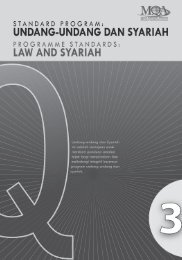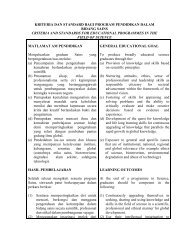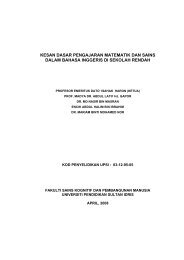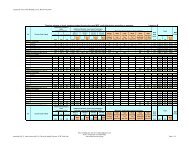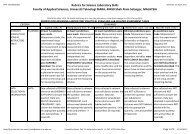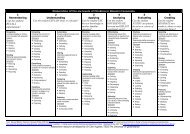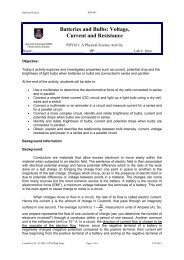Basic Physics II Evidences - DrJJ - UiTM
Basic Physics II Evidences - DrJJ - UiTM
Basic Physics II Evidences - DrJJ - UiTM
Create successful ePaper yourself
Turn your PDF publications into a flip-book with our unique Google optimized e-Paper software.
Material SciencePHY407Universiti Teknologi MARAFakulti Sains GunaanBatteries and Bulbs: Voltage,Current and ResistancePHY407: A Physical Science ActivityName:____________________________ HP: ____________________ Lab # 5:Objective:Today’s activity explores and investigates properties such as current, potential drop and thebrightness of light bulbs when batteries or bulbs are connected in series and parallel.At the end of the activity, students will be able to:• Use a multimeter to determine the electromotive force of dry cells connected in seriesand in parallel.• Connect a simple direct current (DC) circuit and light up a light bulb using a dry cell,wires and a switch.• Connect a multimeter or an ammeter in a circuit and measure current for a series andfor a parallel circuit.• Connect a more complex circuit, identify and relate brightness of bulbs, current andpotential drops when bulbs are connected in series.• Identify and relate brightness of bulbs, current and potential drops when bulbs areconnected in parallel.• Obtain, explain and describe the relationship between bulb intensity, current, voltageresistance and power in a series and in a parallel circuit.Background InformationBackground:Conductors are materials that allow excess electrons to move easily within thematerial when subjected to an electric field. The existence of electric field is then associatedwith electrical potential energy and hence potential difference which is the ratio of the workdone on a test charge (in bringing the charge from one point in space to another) to themagnitude of the test charge. Charges which move, do so in the presence of electric field ordue to potential difference or voltage between points in a material. The charges can comefrom many sources but the most common source is the battery. A battery is the source ofelectromotive force (EMF), a maximum voltage between the terminals of a battery. This emfis the main agent to cause charge to move in a circuit.When charges move or flow in a circuit, the rate of its flow is called electric current.Hence the current I, is the amount of charge in Coulomb, that pass through an imaginary∆qsurface in one second. The average current is I = , measured in units of Ampere (A). So,∆tone ampere represents the flow of one coulomb of charge (can you determine the number ofelectrons involved?) through a conductor within a period of one second. Another commonunit is the milliampere (mA) or 10 -3 A. In a circuit, the direction of current flow is chosen to bethe opposite of the electron flow. Hence, since the negative terminal of a battery isnegatively charged (negative potential) compared to the positive terminal, then current willflow beginning from the positive terminal of a battery and ending at the negative terminal ofCreated by Dr. JJ, FSG, <strong>UiTM</strong> Shah Alam Page 1 of 7 3/3/2010




